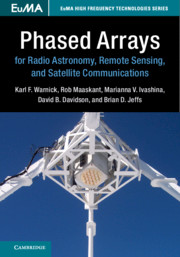Book contents
- Frontmatter
- Contents
- Preface
- Acknowledgements
- Notation and Units
- 1 Phased Arrays for High-sensitivity Receiver Applications
- 2 Active Antenna Receivers
- 3 Antenna Examples
- 4 Transmitting Arrays, Network Analysis, and Pattern Overlap Integrals
- 5 Array Receiver Theory and Modeling
- 6 Figures of Merit for Active Receiving Arrays
- 7 Design and Optimization of Phased Array Antennas
- 8 Numerical Modeling of Phased Array Antennas
- 9 Analog Front End, Array Elements, and Receiver Electronics
- 10 Array Signal Processing, Calibration, and Beamforming
- 11 Interferometric Arrays and Synthesis Imaging
- 12 Real Time Digital Signal Processing
- Index
- References
6 - Figures of Merit for Active Receiving Arrays
Published online by Cambridge University Press: 14 July 2018
- Frontmatter
- Contents
- Preface
- Acknowledgements
- Notation and Units
- 1 Phased Arrays for High-sensitivity Receiver Applications
- 2 Active Antenna Receivers
- 3 Antenna Examples
- 4 Transmitting Arrays, Network Analysis, and Pattern Overlap Integrals
- 5 Array Receiver Theory and Modeling
- 6 Figures of Merit for Active Receiving Arrays
- 7 Design and Optimization of Phased Array Antennas
- 8 Numerical Modeling of Phased Array Antennas
- 9 Analog Front End, Array Elements, and Receiver Electronics
- 10 Array Signal Processing, Calibration, and Beamforming
- 11 Interferometric Arrays and Synthesis Imaging
- 12 Real Time Digital Signal Processing
- Index
- References
Summary
The single antenna receiver reviewed in Chapter 2 can be fully characterized using classical antenna terms, such as directivity, gain, radiation efficiency, noise figure, noise temperature, and sensitivity. For an active array receiver, only the first and last of these figures of merit (directivity and sensitivity), are well-defined concepts. The pattern directivity is well defined and in principle can be measured for any receiver (see Sec. 5.2), and sensitivity can be determined from the SNR achieved with a signal of interest of known intensity. The other antenna terms require special treatment of the effects of antenna losses and amplifier stages and other nonreciprocal components in the active array system. In this chapter, we use the analytical framework developed in Chapters 4 and 5 to define efficiencies, antenna gain, system noise, and other figures of merit in a way that properly accounts for antenna losses and active, nonreciprocal components in the active antenna receiver system.
Specialized figures of merit have been widely used in the phased array antenna community for many decades. For transmitting arrays, the power radiated by one element in the array accounting for active impedance mismatch is measured by the element efficiency of Hannan [1] for transmitting arrays. To characterize the performance of a receiving array, the array signal processing community employs the SNR gain of the array relative to a single sensor, or the array gain, which is well defined and can easily be applied to any receiver system, no matter how complicated. All that is required is an identifiable output voltage or power and a measure of the signal and noise contributions at the output, so that the SNR at the output of the receiver system can be quantified. The multiple input multiple output (MIMO) communications community has developed other figures of merit that focus on measuring the performance of MIMO antenna arrays in terms of antenna diversity and channel capacity.
For high sensitivity applications, where optimizing the system noise performance is particularly critical to achieving stringent design goals, fine characterization of the efficiency and noisiness of critical components and subsystems has required the development of additional figures of merit for active array receivers. The most recent revision of the IEEE Standard for Definitions of Terms for Antennas [2] includes new terms for active antenna arrays that have resulted from research in the field of high sensitivity phased array receivers for radio astronomy.
- Type
- Chapter
- Information
- Publisher: Cambridge University PressPrint publication year: 2018

